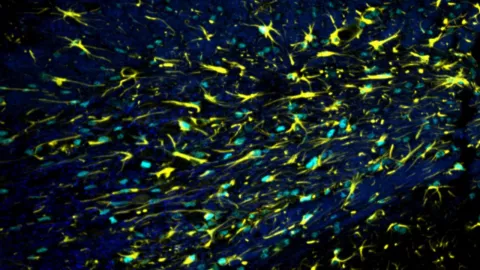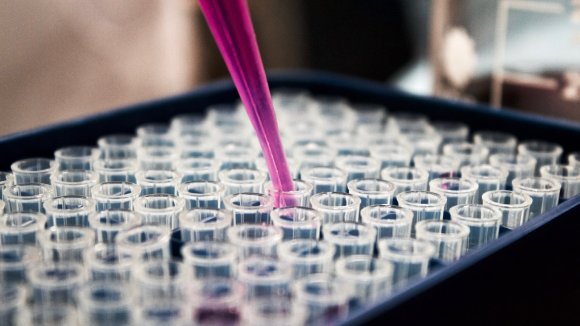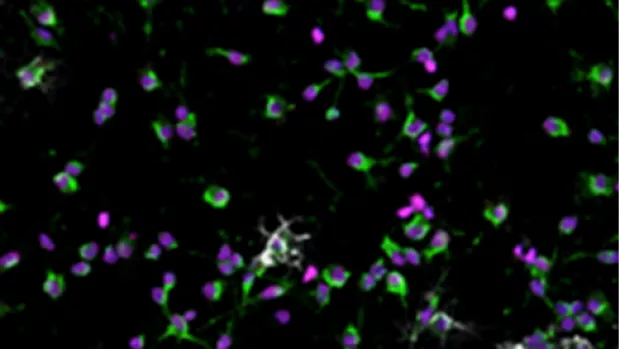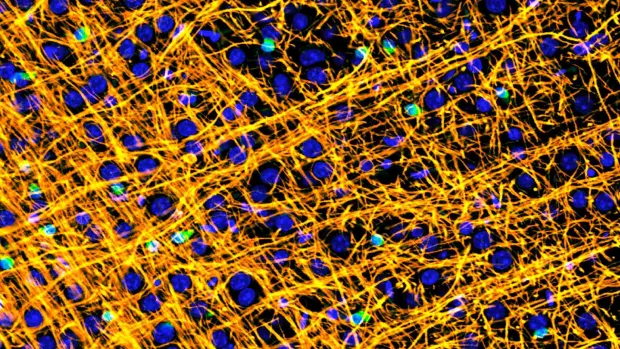
New research shows star-shaped cell could improve myelin repair
The astrocyte is named for its star-like appearance under the microscope. And researchers from the University of Edinburgh found it could play an important role in repairing lesions in the MS brain.
A team of researchers have been exploring the star-shaped brain cells, astrocytes, for years. Now, they’ve found astrocytes could help myelin repair if certain properties are boosted.
The astrocyte is more common than the nerve cell in the brain. Previous research found astrocytes arrive in the immune attack in MS. They form a border around a lesion, like scar tissue. But until now, the link between astrocytes and their potential to repair myelin was unclear.
What did they find?
The team from the MS Society Edinburgh Centre for MS Research used mice with an MS-like condition. And they had two main findings:
- During myelin repair, astrocytes keep myelin-making cells alive by sending them cholesterol.
- Just by boosting the cholesterol-giving properties of astrocytes with drugs, the team could improve myelin repair in lesions.
Why is this important?
In the search for myelin repair treatments, researchers often focus just on changing the myelin-making cells. And this is important. But this research highlights how drugs which change other brain cells could also benefit myelin repair. It could lead towards a new approach for myelin repair treatments.
Professor Veronique Miron, MRC Senior Non-Clinical Fellow and UK DRI Group Leader at University of Edinburgh who led the study, says "We already know astrocytes are the most common cell type in MS lesions. And yet their role in myelin repair is unclear.
We were excited to discover they have a 'starring' role in keeping myelin-forming cells alive during the repair process. And to discover potential drug strategies to target this protective function. In the future, we think combining different treatments which work on different brain cells could help people with MS."
Read an interview with Veronique about her previous work on myelin repair

If researchers boost certain properties of astrocytes with drugs, it benefits the myelin-making cells.
Dr Catherine Godbold, our Research Communications Manager, says “More than 130,000 people live with MS in the UK. And many have no treatment to stop their MS getting worse. Discovering how to repair damaged myelin is one of the holy grails of MS research. So it’s really exciting to learn that astrocytes may have the potential to boost myelin repair.
“Studies like this are crucial in improving our understanding of what happens after myelin becomes damaged and how it can be repaired. We need more research to better understand the interactions between astrocytes and myelin-making cells in people with MS. But these findings take us another step closer to our goal to stop progression for everyone with MS.”
How did they do this?
The researchers saw results from boosting astrocytes in mice with an MS-like condition. But they also showed astrocytes were supplying cholesterol in the same way to the brain lesions of people with MS. This was found by using samples of brain from the MS Tissue Bank. So the researchers think the same approach of boosting astrocytes could work for people with MS.
Read more about how the Tissue Bank is helping scientists find new treatments for MS



